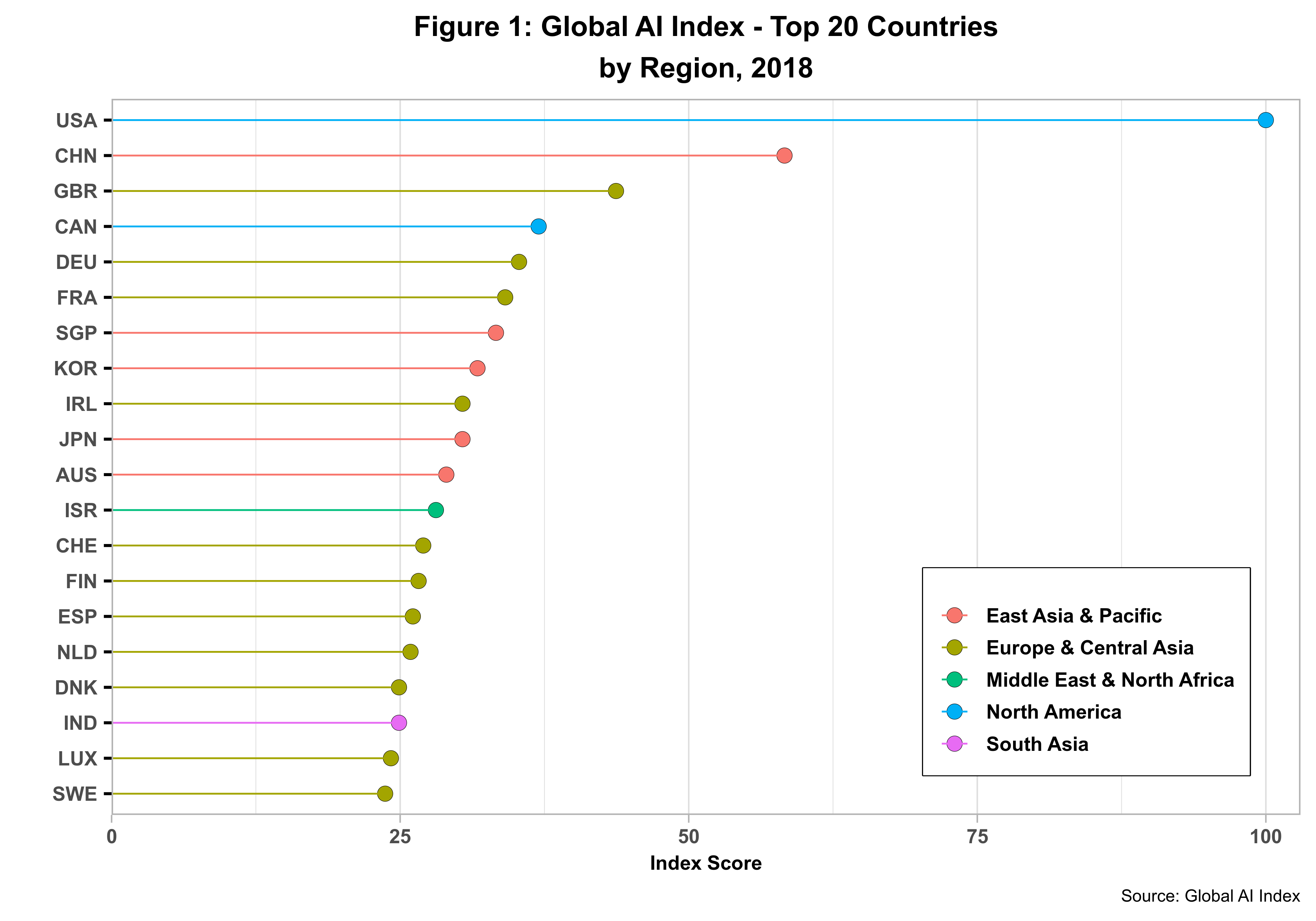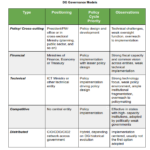As Artificial Intelligence (AI) seemingly continues to permeate all interstices of society, measuring its undaunted progress in the age of data is more than a priority. In a previous post, I share some insights on the Global AI Readiness Index that covered almost all UN member states. 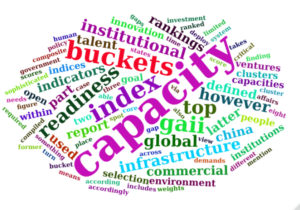 The new Global AI Index (GAII), created by Tortoise media with the support of experts from government, academia and the business sector, is geographically less ambitious but aims at a more sophisticated target. It covers 54 countries and its core goal is not readiness but rather capacity. The company informs us that the index is a response to demands from some government on the subject. However, the report is intended not only for governments but also for businesses and communities.
The new Global AI Index (GAII), created by Tortoise media with the support of experts from government, academia and the business sector, is geographically less ambitious but aims at a more sophisticated target. It covers 54 countries and its core goal is not readiness but rather capacity. The company informs us that the index is a response to demands from some government on the subject. However, the report is intended not only for governments but also for businesses and communities.
In spite of obvious differences, having two or more AI indices allows for comparisons across countries and regions, provided that needed qualifications are explicitly cited. Not that associating readiness with capacity demands the deployment of a sophisticated deep learning algorithm. Any readiness index should be able to assess the capacities that are in place to deploy AI successfully in a given country. In this light, readiness is a much broader category and should strive to capture many more parameters into the analysis.
In international development circles, capacity is a core outcome of almost any intervention. The central idea here is that people, organizations and institutions should develop their own capacities to take care of their affairs without having to depend on external actors or resources. The latter are surely welcome but as complements, not as critical catalysts. Nevertheless, the GAII does not endorse this perspective. Instead, it states that capacity is “…the amount of something that a system can contain or produce…” In my view, concepts such as something and system are equivocal at best. This does not detract from the report. Indeed, capacity, as defined above, is captured in some indicators and composite indices compiled.
Before we dig any deeper, let us first get rid of the rankings hype. Figure 1 shows the top 20 GAII countries by region.
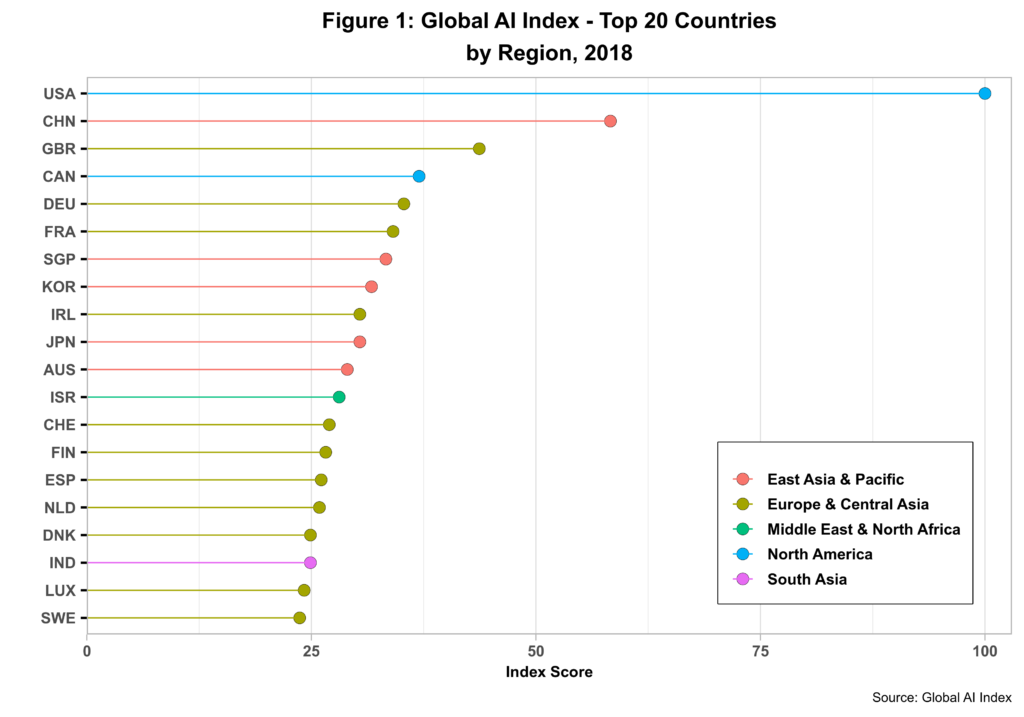 In this film, the US is well ahead of all other countries, China being a distant second with a score that is almost half the leaders’. Most other top-20 countries have scores between 25 and 40. Furthermore, most nations are from Europe (11) followed by Asia with 6. With a few exceptions, most of these countries are also part of the top-20 Global AI Readiness Index, but the rankings are entirely different. In the latter, Singapore takes the top spot, while the US is ranked 5th and China 20th. The exception is the UAE that here is part of the top-20 team while Israel is just one spot down from China.
In this film, the US is well ahead of all other countries, China being a distant second with a score that is almost half the leaders’. Most other top-20 countries have scores between 25 and 40. Furthermore, most nations are from Europe (11) followed by Asia with 6. With a few exceptions, most of these countries are also part of the top-20 Global AI Readiness Index, but the rankings are entirely different. In the latter, Singapore takes the top spot, while the US is ranked 5th and China 20th. The exception is the UAE that here is part of the top-20 team while Israel is just one spot down from China.
At any rate, such radical variations in rankings are no doubt the result of indicator and parameter selection across the two indices. Statistically, the gap between the US and all other countries is perhaps more concerning. In the US actually an outlier of sorts with a perfect score? If so, what are the capacity and policy implications of such a finding?
The GAII is comprised of three pillars or clusters 1. Infrastructure. 2. Innovation. And 3. Investment. Each cluster, in turn, includes two or more sub-pillars or buckets. Eight buckets are defined this way. Each sub-pillar consists of one or more relevant indicators used to compute a composite index for each bucket. According to the GAII report, more than 100 indicators were compiled and used to complete this process.
The global AI index is then computed as the weighted average of the eight buckets, each having a different weight within the respective cluster, and defined according to criteria carefully detailed in the documentation. The report spends a bit of time defending the selection of weights, informing us that a randomized weighting approach was used to diminish bias selection. However, it is possible to argue that, on those same grounds, weights should not be required as their impact on rankings is negligible in any case.
Figure 2 below depicts this scheme for the top ten GAII countries.
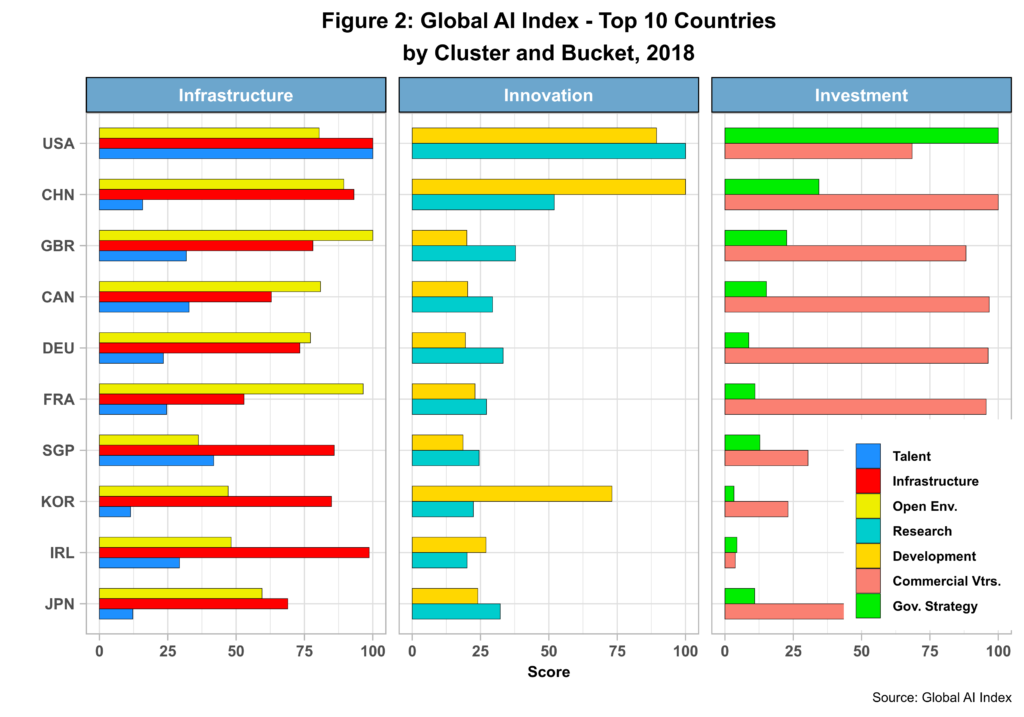 Talent, Infrastructure and Open Environment are the thee buckets comprising the Infrastructure pillar. Innovation is limited to Research and Development, while Investment includes Commercial Ventures and a national AI strategy.
Talent, Infrastructure and Open Environment are the thee buckets comprising the Infrastructure pillar. Innovation is limited to Research and Development, while Investment includes Commercial Ventures and a national AI strategy.
As expected, the chart provides a more nuanced view of the actual scores and ranks. The US still leads in 5 of the 8 buckets but is ranked 6th in Open Environment, 2nd in Development and 13th in Commercial Ventures. China takes the top-notch in both Development and Commercial Ventures while the UK is first in terms of Open Environment. However, the gaps in scoring in the buckets where the US lead is still quite ample. Are catching-up and leap-frogging totally out of the question here? Should most other countries be discouraged by these incredible gaps?
Capacity, as defined above, is part and parcel of the many indicators used to construct each bucket. However, the buckets proposed do not seem to be organized accordingly.
Capacity is both means and end. As a means, capacity is required to create policies, deploy infrastructure, and handle commercial and financial affairs, to mention a few. On the other hand, capacity itself needs to be developed or be in place to be able to propel the former. Here, distinguishing between human and institutional capacities is critical. Most tend to privilege the former via training, skills building, talent development and mentoring, to mention the most well-known. The latter, in turn, is rarely adequately addressed. Fortunately, the UN Sustainable Development Goals are trying to address this gap via goal 16 and various of its targets.
For example, talent needs to operate within an institutional or organizational structure that is conducive for innovation and thus attracts such people. Many talented people from the Global South have access to the best academic institutions and knowledge in the West where institutional capacity is most advanced – including democratic institutions. However, when they return to their home countries, they have a hard time finding the institutional structures that will allow them to maximize their talent within the existing local context.
Any capacity-related index should thus harness the above. In the case of the GAII, clusters and buckets should be rethought accordingly. Policy, Technology, Infrastructure (not limited to telecom pipes) and Capacity should be part of the equation. The first three clusters require specific levels of capacity development. That latter sets capacity, human and institutional, as a goal.
Cheers, Raúl
